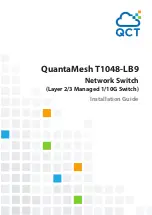
STP Overview
169
in the figure above, the priorities of Switch A, B and C are 0, 1 and 2 and the path
costs of their links are 5, 10 and 4 respectively.
1
Initial state
When initialized, each port of the Switches will generate the configuration BPDU
taking itself as the root with a root path cost as 0, designated bridge IDs as their
own Switch IDs and the designated ports as their ports.
■
Switch A:
Configuration BPDU of AP1: {0, 0, 0, AP1
}
Configuration BPDU of AP2: {0, 0, 0, AP2
}
■
Switch B:
Configuration BPDU of BP1: {1, 0, 1, BP1
}
Configuration BPDU of BP2: {1, 0, 1, BP2
}
■
Switch C:
Configuration BPDU of CP2: {2, 0, 2, CP2
}
Configuration BPDU of CP1: {2, 0, 2, CP1
}
2
Select the optimum configuration BPDU
Every Switch transmits its configuration BPDU to others. When a port receives a
configuration BPDU with a lower priority than that of its own, it will discard the
message and keep the local BPDU unchanged. When a higher-priority
configuration BPDU is received, the local BPDU is updated. And the optimum
configuration BPDU will be elected through comparing the configuration BPDUs of
all the ports.
The comparison rules are:
■
The configuration BPDU with a smaller root ID has a higher priority
■
If the root IDs are the same, perform the comparison based on root path costs.
The cost comparison is as follows: the path cost to the root recorded in the
configuration BPDU plus the corresponding path cost of the local port is set as
X, the configuration BPDU with a lower X has a higher priority.
■
If the costs of path to the root are also the same, compare in sequence the
designated bridge ID, designated port ID and the ID of the port via which the
configuration BPDU was received.
3
Specify the root port and designated port, block the redundancy link and update
the configuration BPDU of the designated port.
The port receiving the optimum configuration BPDU is designated to be the root
port, whose configuration BPDU remains the same. The Switch calculates a
designated port BPDU for every other port: substituting the root ID with the root
ID in the configuration BPDU of the root port, the cost of path to root with the
value made by the root path cost plus the path cost corresponding to the root
port, the designated bridge ID with the local Switch ID and the designated port ID
with the local port ID.
The Switch compares the calculated BPDU with the BPDU of the corresponding
port. If the BPDU of the corresponding port is better, the BPDU of the port remains
the same. If the calculated BPDU is better, the port will be the designated port,
and the port BPDU will be modified by the calculated BPDU.
Summary of Contents for Switch 4500 26-Port
Page 16: ...14 ABOUT THIS GUIDE...
Page 58: ...56 CHAPTER 2 PORT OPERATION...
Page 104: ...102 CHAPTER 5 NETWORK PROTOCOL OPERATION...
Page 130: ...128 CHAPTER 6 IP ROUTING PROTOCOL OPERATION...
Page 154: ...152 CHAPTER 7 ACL CONFIGURATION...
Page 228: ...226 CHAPTER 11 802 1X CONFIGURATION...
Page 250: ...248 CHAPTER 14 DEVICE MANAGEMENT...
Page 280: ...278 CHAPTER 15 SYSTEM MAINTENANCE AND DEBUGGING...
Page 312: ...310 CHAPTER 18 NTP CONFIGURATION...
Page 340: ...338 CHAPTER 19 SSH TERMINAL SERVICES...
Page 350: ...348 CHAPTER 20 PASSWORD CONTROL CONFIGURATION OPERATIONS...
Page 388: ...386 APPENDIX B RADIUS SERVER AND RADIUS CLIENT SETUP...
















































